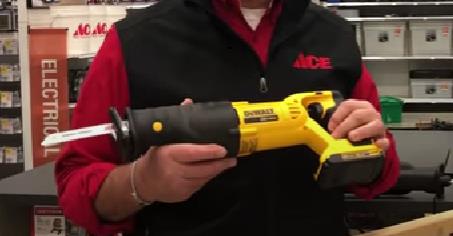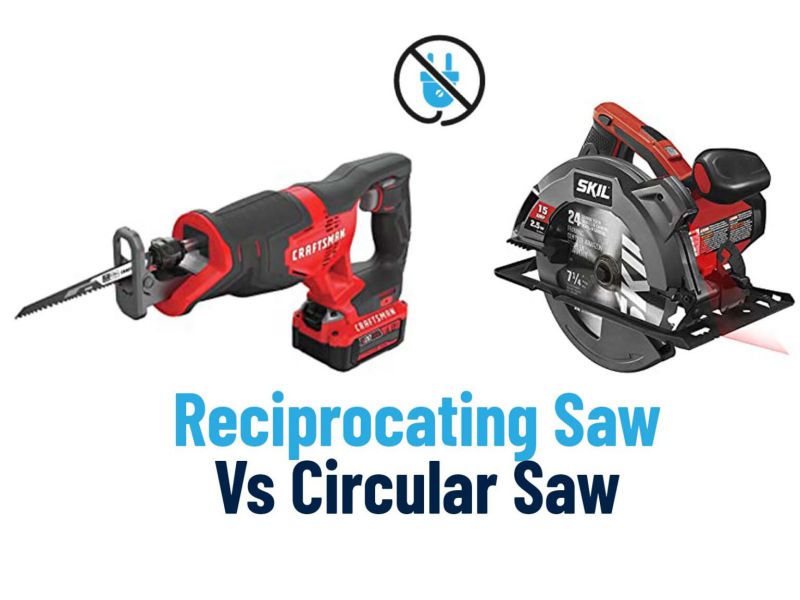When it comes to woodworking and DIY projects, having the right tools is essential. In this article, I’ll break down the differences between reciprocating saw vs circular saw, as well as their uses in various projects.
A reciprocating saw and a circular saw are two important power tools that can be used for a wide range of tasks, such as cutting wood, cutting metal, and tearing things down. Both tools have distinct features and capabilities that make them suitable for various tasks.
In this article, I will cover the differences between reciprocating saws and circular saws, as well as their respective applications and pros and cons.
Major Differences Between Reciprocating Saw vs Circular Saw
A reciprocating saw is a power tool that uses a back-and-forth motion to cut materials, making it ideal for demolition and renovation work. A circular saw, on the other hand, uses a rotating blade to make clean, precise cuts in wood and other materials, making it more suitable for construction and woodworking.
Lets look the huge difference between them.

A. Design
The most noticeable difference between reciprocating and circular saws is their design.
- Blade Shape: Reciprocating saws have a narrow, straight blade that moves back and forth quickly. Circular saws, on the other hand, have a round blade that continuously rotates.
- Blade Movement: The blade of a reciprocating saw moves up and down in a straight line. On the other hand, a circular saw blade moves in a circular motion.
B. Strength and Performance
The power and performance of a reciprocating saw and a circular saw differ depending on the tool’s design.
- Reciprocating Saw: Reciprocating saws are more powerful than circular saws and can handle more demanding applications. They are also more versatile because they can use different blades, including specialized blades for cutting metal, plastic, and other materials.
- Circular Saw: Compared to reciprocating saws, circular saws are lighter and more compact, making them easier to handle and manoeuvre. They are also less likely to vibrate, making them a better option for prolonged use.
C. Capabilities for Cutting
The cutting capabilities of reciprocating and circular saws differ depending on each tool’s blade type and design.

- Reciprocating Saw: Reciprocating saws can make plunge cuts and cut in small spaces. They can also be fitted with specialized blades that can cut through various materials, making them versatile demolition tools.
- Circular Saw: A circular saw is used to cut straight lines in wood, metal, and other materials. They are more efficient when cutting large pieces of material and can make bevel cuts at various angles.
D. Uses
- Uses of Reciprocating Saw
- Demolition Work: Because they can cut through wood, metal, and plastic, reciprocating saws are an essential tool for demolition work. They can be used to dismantle structures quickly and efficiently, making them a popular choice for contractors and demolition crews.
- Plumbing and Electrical Work: Reciprocating saws can also be used for plumbing and electrical work. They are ideal for installation and repair work because they can cut through pipes and conduits.
- Pruning and Gardening: Reciprocating saws can also be used for pruning and gardening. They can be outfitted with specialized blades designed for cutting through wood and other materials, making them excellent tools for landscaping and gardening.
- Uses of Circular Saw

- Carpentry and Woodworking: Circular saws are a must-have tool for carpentry and woodworking. They are popular among woodworkers and carpenters because they can make precise cuts in wood, metal, and other materials.
- Metal Cutting: Professional circular saw blades can be used to cut metal. They can be fitted with specialized blades designed for metal cutting, making them a valuable tool for metal fabrication work.
- Concrete Cutting: Circular saws can be outfitted with concrete cutting tools ideal for construction and masonry work. They can make precise cuts in concrete, brick, and other building materials, making them a popular choice among contractors and do-it-yourselfers.
E. Advantages and Disadvantages
- Reciprocating Saw: The versatility, power, and ability to make plunge cuts and cut in tight spaces are all advantages of reciprocating saws. Reciprocating saws’ disadvantages include their bulk and weight, making them difficult to handle and manoeuvre.
- Circular Saw: Circular saws are advantageous due to their compact design, ease of use, and precision cutting capabilities. Circular saws’ disadvantages include their limited cutting capabilities and inability to make plunge cuts.
The Comparison Table: Reciprocating Saw or Circular Saw
Here I will share a table so that you can easily understand Reciprocating saw vs circular saw, which one is right for your project
| Feature | Reciprocating Saw | Circular Saw |
|---|---|---|
| Cutting Capabilities | Versatile, Ideal for demolition, plumbing & electrical, pruning & gardening | Precise, Ideal for carpentry & woodworking, metal cutting, concrete cutting |
| Speed | Lower | Higher than reciprocating saw |
| Blade Aggressiveness | More Aggressive | Less Aggressive |
| Blade Types | Variety | Typically limited to one or two blade types |
| Blade Length | Shorter | Longer |
| Hands Required | One-handed | Two hands |
| Weight | Lighter | Heavier than reciprocating saw |
| Vibration | More | Less |
| Kickback | More Likely | Less Likely |
| Price | More Expensive than circular saw | Less Expensive |
Similarities Between Circular Saw and Reciprocating Saw:
- Both are power tools used to cut various materials such as wood, metal, and plastic.
- Both are available in corded and cordless versions, allowing users to select the best tool for their needs.
- Both tools are available in various sizes, making them suitable for multiple projects and applications.
- Circular and reciprocating saws require regular maintenance and cleaning to ensure they last as long as possible and perform optimally.
FAQ- Reciprocating saw vs Circular saw
What is a Recip saw good for?
A reciprocating saw is a power tool that uses a reciprocating motion to cut through materials. It is a versatile tool that can be used for a variety of tasks such as cutting pipes, metal, and wood. A reciprocating saw is a good choice for projects that require a lot of cutting or for projects that require a precise cut.
What is a circular saw good for?
A circular saw is a power tool that uses a circular blade to cut through materials. It is a good choice for projects that require a straight cut or for projects that require a large cut. Circular saws are also good for cutting through thick materials.
What is better a reciprocating saw or a circular saw?
Task and preference determine it. Due to its lower cost, a circular saw is utilized more for home DIY projects than a reciprocating saw, which is excellent for cutting metal and making quick, rough cuts. Circular saws produce less vibration and kickback and are easier to control. A reciprocating saw or a circular saw relies on your work and preferences.
Final Words
Finally, reciprocating and circular saws are two essential power tools for various applications. Both tools have different features and abilities, so it’s important to think about what each job needs before choosing a tool.
No matter if you are a contractor, a do-it-yourselfer, or a woodworker, you need to know the difference between a reciprocating saw and a circular saw to make sure you use the right tool for the job.
I hope you enjoyed this answers your question about the difference between reciprocating saw vs circular saw. If you have any other questions, please let me know in the comments section below.




8 thoughts on “A Great Comparison of Reciprocating Saw vs Circular Saw”
Comments are closed.